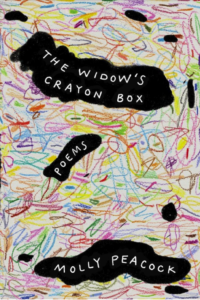By Kathryn MacDonald 
The Widow’s Crayon Box
by Molly Peacock
W.W. Norton & Company (2025)
The Widow’s Crayon Box is Molly Peacock’s eighth poetry book, and from the prologue poem through the four sections of the collection, readers are treated to the fruits of Peacock’s honed skill.
Peacock’s collection unveils the widow’s initiation through passages of caregiving, loss, and eventually into death’s aftermath. The poems are accessible, but from the threshold poem onward, they are also nuanced with image and metaphor, as in the first poem, “Touched”:
… I sense,
the dip of the oar, a canoe being launched.
I’m the oar, but I’m the water, and sense
At once initiation and response.
With “Touched,” Peacock opens the door to the long narrative poetry cycle that follows. Poem-by-poem, readers are brought into the totally consuming world of love, caregiving, and the surprise of death’s knocking, the getting lost in it, the knife-edge of grief that takes us inside, and a look at what death leaves us carrying.
In the title poem, she uses a strike-through tactic, which does three things: it creates a sense of the speaker’s struggle to find the best word; it creates feelings of immediacy and intimacy; and it layers the poetry with nuance. The second technique is the way she creates repetition, echoes. For example, the first poem, #1 of the long titular poem, “The Widow’s Crayon Box,” ends with the words: “Then I yield.” The second poem, #2 of the sequence begins: “I yield to a turquoise sky….” The poem concludes: “Your death face, an abandoned clay quarry / filled with memory water: I’m sorry, sorry, sorry. She varies the beginning of #4: “Often when crying, I say ‘I’m sorry,’….” Later, in other sections, Peacock echoes images, thoughts, in looser, less-structured ways.
Another strategy that the poet uses is the unifying impact of the colours in the crayon box itself. In #6 of the titular poem, with the aid of helpers, she packs her husband’s clothes. After they leave, she unpacks the bags: “I pluck out thirty-eight pairs of socks and lay / them on the table—stripes and checks, a combo / of Crayola colors: mango-tango, / radical red, purple heart, and shadow…” (7). Images, colour. All the time, we’re glimpsing the man, the spouse/friend/lover. “You had the palate of a little boy / and the carbohydrate capacity / to absorb an inch-thick layer of cocoa / with piggy pink and laser lemon dimples” (#13). The crayons are a literary conceit that works.
One of my favourite poems in the collection begins the second section, Before (21):
THRESHOLD
We’d unhitched the shutters the night before
and went to sleep on the pallets we’d pushed
together to make a prenuptial bed,
the window framing a darkness we ignored
(too exhausted to make love), heads crushed
into skimpy pillows. We had fled
the first forty-five years of our lives for
this Spartan room, no surface lush
with objects, just a table and a lamp,
…
…a threshold—and we’d arrived there.
We learn much about the couple, the situation, the before of their story.
The poems in Part Three are poignant with growing acceptance of the inevitability of death: “You’d stopped being a mate, / stopped thanking. I’d begun drying up rough / as a towel in wind” (“Deciding to End Your Life, You Thank Me,” 57). In another poem, the reader is addressed directly: “Have you received thoughts / And wondered why they’ve not / Occurred to you before? // They could be his” (no period, open-ended, “The Next World is One of Ideas,” 61). She guides us down the rabbit hole but doesn’t leave us there.
The fourth section, Afterglow, Peacock questions: “How does the realization arrive? / I don’t know—it was suddenly here. / I marked his death each month for most of a year. / At first the relief allowed me to thrive. / Then: I watched a purpled loneliness creep / up the days like a line of infection / from a poison bite up an arm. Then: a leap / and the realization…” (“The Realization,” 75). The realization may surprise you.
The penultimate poem, “Widow in the Kitchen with a Yellow Apple” (82-84) is a favourite. Near the end, she shares the surreal impact of the loss:
You’d been so real each
hair of your beard glistened
with the outside’s cold air.
The hair on your knuckles
gripping the black handle
curled in little squiggles
as if drawn by a fine
line marker: I saw them,
saw them, the point
of my red paring knife
poised at the yellow peel,
you’d been real.
The final poem, “Honey Crisp,” is a delight to read. The humour that seeps into the collection in a seemingly scattered way, rises here: “Hello wizenface, hello apple. // You were earmarked for the day / he slipped from my arms & we both / slid to the floor….”
Molly Peacock has written “After my husband died, I cried for twenty-eight days straight. On the twenty-ninth day, I woke without tears, picked up a blue mechanical pencil, and began to write the poems that would become The Widow’s Crayon Box” (The Bibliophile newsletter, 2024-11-22). Through love to grief, rage, and compassion Peacock’s insight, curiosity and humour carry us through the nightmare of losing a loved one and take us out the other side. The Widow’s Crayon Box is a collection to read and reread.
Kathryn MacDonald is the author of Far Side of the Shadow Moon and A Breeze You Whisper. Learn more about her work at kathrynmacdonald.com

